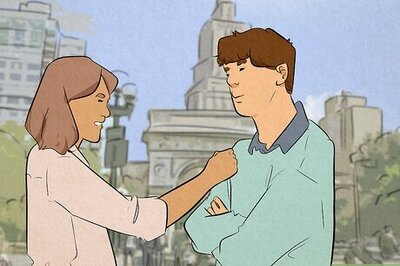
views
Susan B. Anthony Coin Errors
1979 Wide Rim (Near Date) Variety This error occurs when the date is struck too close to the rim of the coin. It’s most commonly seen on the 1979-P Susan B. Anthony coins, due to a batch coin striking error. How to identify: Notice if the date is abnormally close to the rim on a 1979-P coin.
Off-Center Strike This error occurs when the coin is struck off-center when it’s created. While this is a common error amongst coins, it can still hike up the value. How to identify: Look for a design that isn’t centered on the coin.
Double Strike A double strike coin error is quite common and occurs when the coin is struck twice. This causes an overlap in the coin’s design, creating almost a shadow-like image. How to identify: Look for overlapping images or designs.
Wrong Planchet A wrong planchet is an extremely rare coin error and occurs when the coin is struck on the wrong type of metal disc or planchet. An excellent example of this is the 1999-P Susan B. Anthony coin that was struck on a Sacagawea dollar’s golden planchet. How to identify: Notice if the Susan B. Anthony coin has a golden color. A planchet is the blank piece of metal a coin design is stamped on. Susan B. Anthony coins are typically stamped on a copper-nickel planchet.
Overstrike This occurs when a coin is struck over another coin, creating a shadow-like design or double imprint. An overstrike error is what made the 1979-P Susan B. Anthony coin valuable and rare. How to identify: Look for a shadow or outline around the coin’s design or imprint.
Die Breaks and Cracks The die is the stamp or design that’s struck against metal to create a coin. If a die is broken or has a crack, it’ll cause the finished coin to have imperfections, such as raised lines or divots. How to identify: Look for abnormal raised lines or crevices on the coin.
Rare & Valuable Susan B. Anthony Coins
1979-P Susan B. Anthony Dollar Struck on Quarter In Philadelphia in 1979, a big coin striking error occurred. Planchets were mixed up at the Philadelphia Mint, which caused the planchet for the quarter-dollar to be used for the Susan B. Anthony coin. This led to the coins having a smaller diameter, altered edge, and quarter-like appearance. Price estimate: $380+
1981 Susan B. Anthony Coin in Gem Condition Struck at the San Francisco Mint, the 1981-2 Susan B. Anthony dollar is one of the rarest, especially if it’s in MS64 condition or higher. What makes this coin so special is its sharp, clear design and shine. Price estimate: $350+
1981-S Proof Type II Susan B. Anthony Dollar The 1981-S Proof Type II coin was designed by Frank Gasparro, a renowned engraver. Only a limited number of these coins were produced in San Francisco and include a unique coloring. The Type II coin can be distinguished by the coin’s “S” mintmark. Price estimate: $320+
1979-P Susan B. Anthony Dollar with Wide Rim The Susan B. Anthony coin faced criticism when it first came out in 1979 because it was similar in size to the quarter. In an attempt to rectify this, the U.S. Mint altered the design of the rim to be wider. Coins of this variation are a hot commodity because only a few were circulated. Price estimate: $150+
1999-P Susan B. Anthony Dollar Susan B. Anthony coins were discontinued in 1981 from a lack of popularity; however, they made a brief comeback in 1999. A small number of 1999 coins were struck, but what makes these coins valuable is their planchet error. The 1999-P coins were struck on a Sacagawea planchet. The error caused the coins to have the Sacagawea dollar’s golden hue but the Susan B. Anthony design. Price estimate: $80+
About the Susan B. Anthony Coin
The Susan B. Anthony coin was first introduced in 1979 to honor Susan B. Anthony, a women’s suffrage leader. The US Mint produced the coin from 1979 to 1981, with a brief comeback in 1999. The coins were initially met with criticism due to their similar size to quarters; however, over time, the Susan B. Anthony became a prized collectible amongst collectors. The Susan B. Anthony dollar features a head (obverse) with the likeness of Susan B. Anthony and a tail (reverse) of an American eagle landing on the moon.
How to Tell if a Coin is Valuable
A coin’s value lies in its condition, errors, and design. There are many factors that go into how much a coin is worth. Coins worth the most typically have: Minting errors. Look for key coin errors on your coin to see if it’s rare. Common coin errors include a wide rim, off-center strike or design, a wrong planchet, or an overstrike. Excellent condition. An undamaged coin that hasn’t been cleaned or handled is far more valuable than a used coin. Low mintage years. Coins that weren’t in production long tend to be harder to find, making them more valuable. Design variation. Coins made of abnormal metals or struck with planchet variations are considered more valuable. To find the exact worth of your coin, it’s best to bring it to an authenticator or look it up using online resources like PCGS or NGC.
FAQs
How rare are Susan B. Anthony coins? Not all Susan B. Anthony coins are rare; however, specific varieties (specifically those with errors) can be worth some money. Coins made of abnormal planchets or with other design errors are considered rare.
Are Susan B. Anthony coins without errors worth anything? Unfortunately, no. Most Susan B. Anthony coins are worth very little. The coin itself is worth $1. Some collectors may pay a little over the coin’s material value to make an addition to their collection, but without an error, the coins aren’t considered valuable.
What is a "mint"? A mint is a place where coins are manufactured. Think of it as the factory for creating coins! There are currently 6 Mint locations in the United States: Denver, Fort Knox, Philadelphia, San Francisco, Washington, and West Point.
















Comments
0 comment